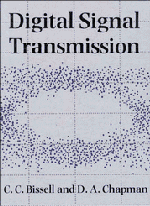Book contents
- Frontmatter
- Contents
- Preface
- 1 Introduction
- PART 1 MODELS
- PART 2 PROCESSES
- 4 Pulses for digital transmission
- 5 Line codes
- 6 Channel codes
- PART 3 DIGITAL TRANSMISSION OVER THE PUBLIC SWITCHED TELEPHONE NETWORK
- Appendix A Fourier series and transforms
- Appendix B Convolution
- Appendix C Modelling applications of spreadsheets
- Answers to numerical exercises
- References
- Index
6 - Channel codes
from PART 2 - PROCESSES
Published online by Cambridge University Press: 05 June 2012
- Frontmatter
- Contents
- Preface
- 1 Introduction
- PART 1 MODELS
- PART 2 PROCESSES
- 4 Pulses for digital transmission
- 5 Line codes
- 6 Channel codes
- PART 3 DIGITAL TRANSMISSION OVER THE PUBLIC SWITCHED TELEPHONE NETWORK
- Appendix A Fourier series and transforms
- Appendix B Convolution
- Appendix C Modelling applications of spreadsheets
- Answers to numerical exercises
- References
- Index
Summary
Introduction
In the Introduction to Part 2, the channel coding layer was identified as being concerned with maintaining the integrity of the conveyed data sequence. In one sense, of course, both line coding and pulse shaping are also chosen with this ultimate end in mind. The precise form of channel coding employed in a particular application depends therefore on the characteristics of the data, the nature of the channel, and the choice of line code and/or pulse shape.
The term channel coding is often used as a near-synonym for error detection/correction coding. Examples discussed in this chapter are Hamming codes, cyclic redundancy check (CRC), and convolutional coding. We have chosen a rather wider interpretation of the term channel coding, however, so as to include techniques sometimes used to make up for limitations inherent in a particular line code or signalling scheme. For example, the line codes HDB3 and CMI guarantee a good timing content, whereas AMI does not. Systems using AMI therefore sometimes incorporate scrambling before line coding to reduce the probability of long strings of data without transitions. Similarly, differential coding can be used to overcome the problems of error propagation which can be encountered with partial response signalling.
There is also another reason for treating together such topics as differential coding, scrambling, CRC and convolutional coding. As will be seen in what follows, the implementation of all these processes has much in common, particularly in the use of delay elements, feedback and shift registers.
- Type
- Chapter
- Information
- Digital Signal Transmission , pp. 192 - 230Publisher: Cambridge University PressPrint publication year: 1992



